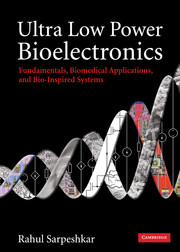Book contents
- Frontmatter
- Contents
- Acknowledgements
- Section I Foundations
- Section II Low-power analog and biomedical circuits
- 11 Low-power transimpedance amplifiers and photoreceptors
- 12 Low-power transconductance amplifiers and scaling laws for power in analog circuits
- 13 Low-power filters and resonators
- 14 Low-power current-mode circuits
- 15 Ultra-low-power and neuron-inspired analog-to-digital conversion for biomedical systems
- Section III Low-power RF and energy-harvesting circuits for biomedical systems
- Section IV Biomedical electronic systems
- Section V Principles for ultra-low-power analog and digital design
- Section VI Bio-inspired systems
- Section VII Energy sources
- Bibliography
- Index
- Epilogue
- References
12 - Low-power transconductance amplifiers and scaling laws for power in analog circuits
from Section II - Low-power analog and biomedical circuits
Published online by Cambridge University Press: 02 December 2010
- Frontmatter
- Contents
- Acknowledgements
- Section I Foundations
- Section II Low-power analog and biomedical circuits
- 11 Low-power transimpedance amplifiers and photoreceptors
- 12 Low-power transconductance amplifiers and scaling laws for power in analog circuits
- 13 Low-power filters and resonators
- 14 Low-power current-mode circuits
- 15 Ultra-low-power and neuron-inspired analog-to-digital conversion for biomedical systems
- Section III Low-power RF and energy-harvesting circuits for biomedical systems
- Section IV Biomedical electronic systems
- Section V Principles for ultra-low-power analog and digital design
- Section VI Bio-inspired systems
- Section VII Energy sources
- Bibliography
- Index
- Epilogue
- References
Summary
The obvious is that which is never seen until someone expresses it simply.
Kahlil GibranIn this chapter, we will discuss low-power transconductance amplifiers and circuits built with them such as first-order filters. Transconductance amplifiers are one of the most widely used building-block analog circuits. They implement a controlled linear conductance, which along with a set of capacitors, suffice to create any linear system with a finite number of state variables. Nonlinear transconductance amplifiers and capacitors can create any similar nonlinear dynamical system if the nonlinearity can be easily implemented by the transconductance amplifier. For example, tanh, sigmoid, and sinh nonlinearities are easily implemented in the subthreshold domain and are useful in a wide variety of computations based on statistical-mechanical exponential primitives.
We will begin by focusing on how to use feedback-linearization techniques to construct a low-power transconductance amplifier capable of wide-linear-range operation in the subthreshold and above-threshold domains. These techniques will involve using the well of the transistor as an input, using a well-known technique called source degeneration, a novel technique that we term gate degeneration, and a technique called bump linearization. We shall analyze how extending the linear range of an amplifier affects its offset and noise. We shall find that extensions of linear range arrive with extensions of dynamic range in thermal-noise-limited filters constructed with transconductance amplifiers but not in similar filters constructed with 1/f-noise-limited amplifiers.
Information
- Type
- Chapter
- Information
- Ultra Low Power BioelectronicsFundamentals, Biomedical Applications, and Bio-Inspired Systems, pp. 301 - 329Publisher: Cambridge University PressPrint publication year: 2010
